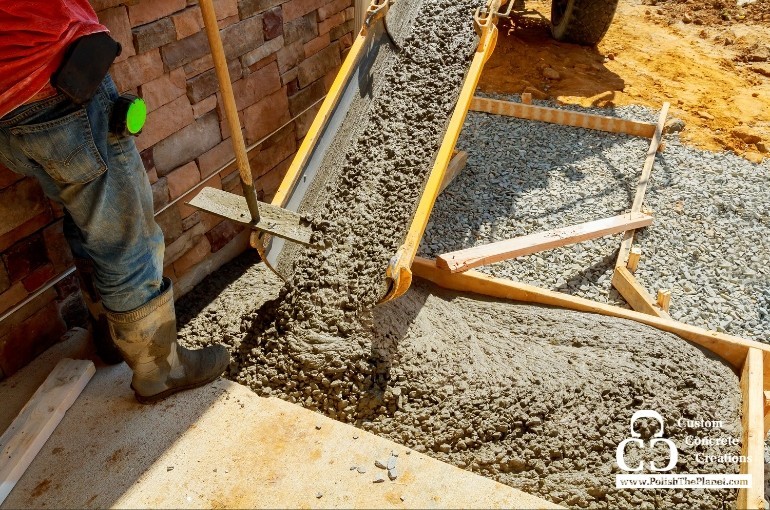
Ever wondered how the creation of concrete began? Concrete has a pretty interesting history! Concrete structures date as far back as 10,000 B.C. The mixture we use today, Portland cement, wasn’t created until the 1800s. To help you learn more about the construction of concrete and how it plays a role in the process concrete contractors use today, our team has put together a timeline of concrete’s many variations and uses over the years!
As far back as 10,000 B.C.
Limestone is the base ingredient for cement, and we see the use of it as far back as 10,000 B.C. Prehistoric people built historic structures before metal tools were even developed. The Göbekli Tepe was built between 9500 and 8000 B.C. It’s the earliest known limestone structure.
6500 B.C.
Desert cisterns were constructed underground to store scarce water. Some of these cisterns still exist today.
5600 B.C.
Historians found old huts that had concrete floors in the 1960s. These huts were built from lime cement, sand, gravel and water.
3000 B.C.
Concrete blocks were used to build the Egyptian pyramids. The ancient builders used straw and mud with limestone, gypsum and clay to hold the blocks together.
2500 B.C.
Stonehenge was built around 2500 B.C. Limestone made up the pillars of this historic structure.
1700 - 1400 B.C.
Minoan society used clay and volcanic ash, called pozzolana, to build floors, foundations and sewers. It’s known as one of the first European civilizations.
1300 B.C.
We see the first lime coating in 1300 B.C. Middle Eastern builders burned limestone and mixed it with water to coat their clay walls.
1000 B.C.
An early form of cement was used to build the vaulted tombs on the Peloponnese peninsula in southern Greece. These tombs can still be seen today.
770 B.C.
The people of northern China used a form of cement to build their part of the Great Wall. They held their bricks together with a mortar made of sticky rice. The wall also contained other materials such as reeds, willow branches, wood, sand, mud, stone and brick.
700 B.C.
Cement that hardens underwater was created during this time. The Middle Eastern civilizations that aided in the creation of desert cisterns were crucial in developing the hydraulic lime that was used to create new waterproof cisterns, houses and floors.
82 A.D.
In 82 A.D., the Roman Colosseum was constructed. It had more than 50,000 seats, and about a third of the structure still stands today.
117 - 125 A.D.
Rome’s Pantheon was built around this time. It’s an unreinforced, heavy concrete dome. The secret to its stability and success still baffles builders today.
300 - 500 A.D.
The Romans began architecture with kilned lime, crushed rocks, sand and water. They built ramps, terraces and roads to connect the entire empire. When they poured their cement mixture into molds, they could then create vaults, domes, aqueducts and bathhouses. Roman concrete is incredibly durable, even to this day.
The 16th Century
In 1507, we saw the creation of the Pont Notre-Dame Bridge in Paris. It was created with a recipe similar to Roman concrete.
The early 17th Century
The creation of modern cement began in Andernach, Germany when a bricklayer mixed volcanic ash, called trass, with lime mortar. This material was water-resistant and strong.
The mid-17th Century
During this time, the Dutch sold trass to France and Britain to use on buildings that needed to be waterproof. The competition for hydraulic building materials was on.
1793
The Eddystone Lighthouse was built by John Smeaton. He found limestone with clay nearby and melted it down into a clinker, which then was mixed with water to create a paste.
1824
Portland cement was invented this year. Joseph Aspdin was an Englishman who burnt limestone chalk and clay in a kiln until there was no carbon dioxide left. He is also known for heating alumina and silica to create a glass-like material that was then mixed with limestone and gypsum.
1836
Strength testing began this year in Germany. Concrete was tested for tensile strength and comprehensive strength, pulling apart and pushing together respectively.
1850s
Concrete reinforced with steel was patented. Joseph Monier poured concrete over steel mesh with the intended use of creating railway sleeper cars, building slabs and pipes. Reinforced concrete is stronger and better for building bridges and skyscrapers.
1880s
Concrete reinforced with iron bars was introduced this year. Ernest Ransome was an engineer in California who learned concrete and iron could bond to any shape. Today the process is called rebar. This system was soon used to create the world’s first skyscrapers, commercial buildings, modern roads and bridges. Pressing steel was also patented this year, allowing engineers to use less steel and concrete in their concrete construction.
Work with our concrete contractors
Concrete is one of the most efficient building materials today. As technology advanced over the years so did the methods concrete contractors use to build with concrete. Custom Concrete Creations is passionate about concrete. We are a leader in the decorative concrete world because of the passion and experience we have with concrete. Contact us today to discuss your concrete project!
